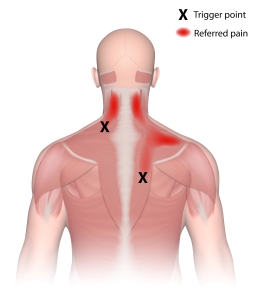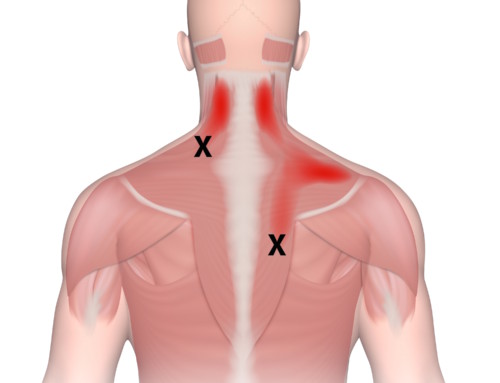TRIGGER POINTS:
WHY STRETCHING IS NOT THE ANSWER

Trigger points cause real problems for athletes.
Not only are they exquisitely painful, but they also affect movement. Trigger points inhibit range of motion by keeping muscles short and stiff. They also weaken muscles, causing them to tire quickly and recover slowly. They produce excessive muscle contraction that can partially disarticulate joints or cause nerve entrapment.
How Does A Trigger Point Form?
- A trigger point is a hyperirritable muscle band with a predictable pattern of pain referral. It forms when the process of muscle contraction and release goes awry. Muscle overload or trauma causes the muscle band to contract too strongly. Such excessive contracture both increases metabolic demand and also squeezes shut the network of capillaries supplying the nutrition and oxygen to the region. This results in a local energy crisis, perpetuating the cycle of contracture. The muscle band cannot release and a trigger point forms.
Why Stretching Doesn’t Work:
- A muscle harboring a trigger point will be too painful to stretch fully. The pain (and subsequent inhibitory reflex) will prevent you from sufficiently lengthening the muscle band.
- What’s more, forcing a stretch will often result in injury (muscle strain) and do nothing to resolve the trigger point. Think of a trigger point like a knot in a rubber band. Stretching the band will cause it to snap, but it will not release the knot. To restore full stretch to that rubber band, you first need to unwind the knot.
Why Acupuncture Is The Most Effective Way To Release Trigger Points:
- The acupuncture needle provides a mechanical disruption to the trigger point.
- It halts the cycle of energy crisis in the muscle. Restored to its full length, the muscle recovers its normal blood supply and metabolism and can function fully.
- Acupuncture doesn’t hurt.
- Many release techniques require direct pressure to the trigger point, which is by definition painful. Often a trigger point is too irritable to tolerate much additional mechanical stimulation. A needle can reach the depth of the trigger point without irritating the hyper-sensitive tissues above or around it. There is simply no other technique that can boast such precision.
- Acupuncture achieves immediate results.
- A single well-placed needle into a trigger point will elicit a twitch followed by reduced muscular tension and increased range of motion. Such immediate feedback is immensely satisfying for someone who has been dealing with pain and dysfunction in that muscle for weeks, months, or even years.
Prevention is Key!
Trigger points form due to persistent muscular contraction, strain or overuse. To prevent their formation,
- Increase training loads slowly.
- Don’t do too much too soon, and make sure you have adequate recovery between workouts. Get enough quality sleep to ensure your body can repair itself efficiently.
- Maintain range of motion and muscle balance.
- This requires some work. Regularly take your body through the OPPOSITE range of motion you use in your sport. A good rule of thumb is to lengthen the agonist, strengthen the antagonist. For cyclists who spend hours in the saddle with forward shoulder posture, this means increasing range of motion in your pectorals and strengthening the rhomboids and other muscles of the upper back. Runners typically benefit from lengthening the hip flexors (psoas, quads) and strengthening the hip extensors (glutes, hamstrings).
- Break up adhesions.
- You need to be doing something on a regular basis to normalize tight, overworked muscle tissue. Supple, flexible muscles don’t get injured. Using a lacrosse ball, a foam roller, or even your fingers, apply direct pressure to a tight muscle band for 8-12 seconds. Taking the muscle through its range of motion while compressing it will break up adhesions before a trigger point forms.





